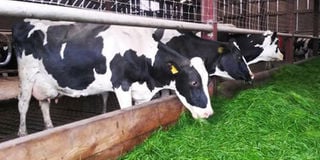What are the merits of zero grazing over free range?

Experts from NARO explained the importance of zero grazing in cattle keeping
Zero grazing is a form of dairy farming where cattle are kept within housing structures; forage is brought to them and with little or no direct contact with pasture land.
With increased pressure of land for human settlement and the absence of resources for farmers to run large scale dairy set ups, zero grazing is increasingly becoming a production system of choice to many.
Since the requirement for land is limited to only the dairy shed and areas to grow forage, zero grazing enables farmers with less land to indulge in intensive dairy farming.
With cattle restricted to dwell only in the shed, there is no excessive trampling or overgrazing of pastures.
Forage can thus be allowed to grow to desired levels and continue to be harvested all year round to feed the cattle, especially when irrigation is done.
The dung collected from the zero grazing units can be tucked away for use as fertilizer in the pastures grown for feeding the cattle.
It can also be used with appropriate harnessing technology, as a source of biogas.
The bio gas can be used by the farm owners for cooking and lighting.
Zero grazed cows consume more grass but spend less time eating in comparison with cattle on free range grazing system.
Cattle here spend more time resting and ruminating, compared with those grazing in the field.
It thus allows the animal to convert its food into production and reproduction easily.
Answered by Samuel Ssewagudde, a veterinary doctor affiliated to Genesis East Africa limited.
What are the disadvantages of zero grazing?
However good it is , zero grazing has some demerits.
The capital requirement to set up structures for housing cattle and handling them could be a limitation.
It is also labour intensive which calls for maximum supervision.
Managing the animals throughout the day involves; cutting grass and conserving some of it, feeding, providing water, checking on signs of ill health, cleaning their dwelling places, milking, looking out for signs of heat or impending birth among others.
For those that have no need for the dung-urine mixture from cattle zero grazing, it can be costly getting rid of it.
Also, cattle is not provided with some softer modification of the ground (sand, loose soil) where they rest, this can lead to foot injury problems.
In countries like Uganda, some cattle sheds are improperly built. They thus can expose cattle to; extreme heat from the sun, unhygienic conditions, improper air flow and injuries from slippery floors.
These can lead to diseases and low milk production.
Answered by Samuel Ssewagudde, a veterinary doctor affiliated to Genesis East Africa limited.




